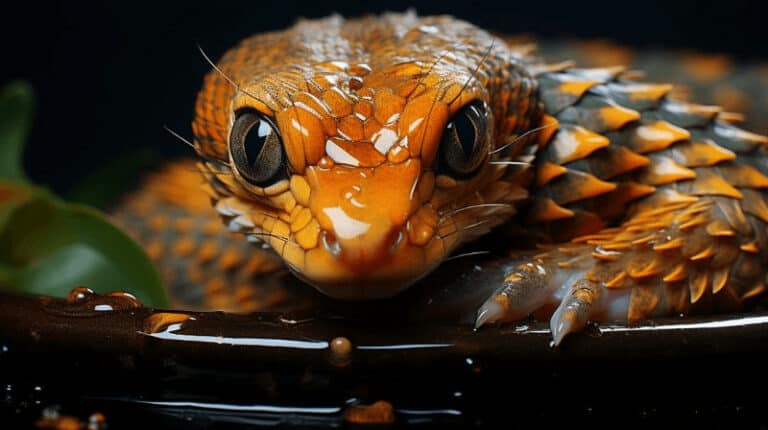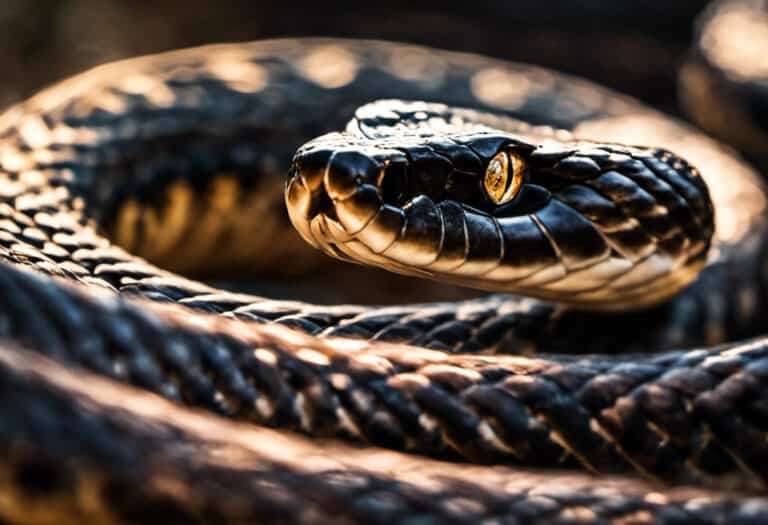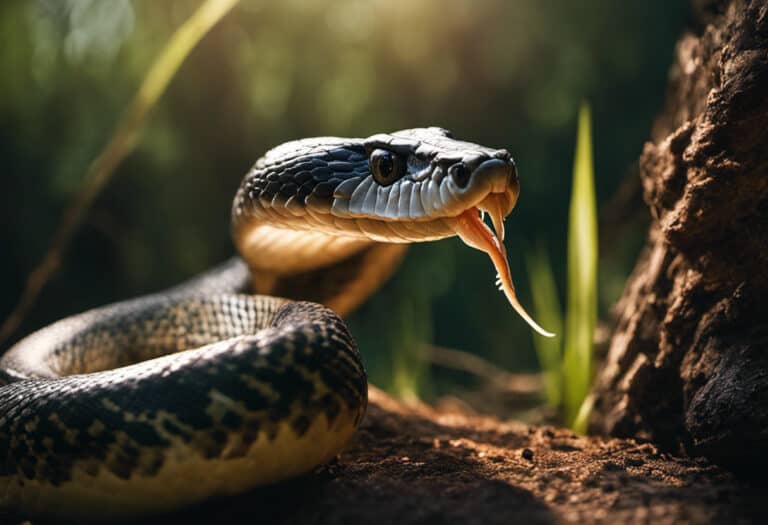Do Any Snakes Eat Plants?
Do you ever wonder if snakes can chow down on plants? Well, get ready to be amazed!
In this article, we’ll explore the fascinating world of snake diets and find out if these slithery creatures can actually munch on some greens.
While snakes are mostly known as carnivores, there are some exceptions to the rule. We’ll dive into their unique digestive system, nutritional needs, and even discuss the potential for snakes to adapt to a mixed diet.
Get ready to unravel the truth about snakes and plants!
Key Takeaways
- Snakes are carnivorous reptiles and their diet primarily consists of other animals.
- Snakes have a unique digestive system and their jaws can stretch to accommodate large prey.
- Snakes require high levels of protein for growth and energy, and calcium for bone health.
- While some snakes occasionally consume small amounts of vegetation, they still rely primarily on animal prey and are not adapted to digest and derive nutrition from plants.
Snakes: Carnivorous Reptiles
Snakes, as carnivorous reptiles, rely on a diet primarily consisting of other animals. Their evolutionary potential has led to fascinating digestive adaptations.
Snakes have unique jaws that can stretch to accommodate large prey, allowing them to swallow their prey whole. The digestive process in snakes is slow, as they’ve specialized enzymes to break down proteins.
However, snakes don’t typically consume plant-based foods as their bodies lack the necessary adaptations to digest and derive nutrition from plants.
Despite their carnivorous nature, there’s potential for snakes to adapt to a mixed diet. While currently existing snakes can’t become vegetarians, some may have evolved in the past to eat certain vegetarian products.
For example, snakes could potentially eat sweet fruit, nuts, or seeds with high fat content without major changes in their digestive system. It’s also possible for snakes to acquire some required microorganisms for digesting plants through the consumption of herbivorous animals.
However, it’s important to note that snakes haven’t yet demonstrated the ability to fully transition to a plant-based diet.
Unique Digestive System of Snakes
The unique digestive system of snakes allows them to consume and process their prey in a remarkable way.
Snakes have the ability to stretch their jaws to accommodate large prey, which they then swallow whole.
Their digestive process is slow, aided by specialized enzymes that break down proteins.
Digestive Adaptations in Snakes
You may be interested to know that snakes have a unique digestive system that allows them to swallow their prey whole. This remarkable adaptation enables them to consume animals much larger than their own size. The impact of diet on snake physiology is significant, as their digestive system is specifically adapted to handle a carnivorous diet.
Here are some key digestive adaptations in snakes:
- Snakes have stretchable jaws that can accommodate large prey.
- They swallow their prey whole, without the need for chewing.
- The digestive process in snakes is slow, as their stomachs have low acidity levels.
- Snakes have specialized enzymes to break down proteins efficiently.
These digestive adaptations allow snakes to extract the maximum nutritional value from their prey and thrive in their natural habitat.
Plant-Based Diets for Snakes
If you’re wondering about snakes and their dietary preferences, it’s important to note that they primarily consume animal-based foods. Snakes are carnivorous reptiles, and their diet consists mainly of other animals such as mammals, birds, fish, and amphibians.
While some snakes may also eat eggs and small invertebrates, they don’t typically consume plant-based foods. This is because snakes have a unique digestive system that’s adapted for breaking down proteins found in animal prey.
They require high levels of protein for growth and energy, as well as essential nutrients like calcium, vitamins, and minerals. Plant-based foods don’t provide the necessary nutrients for snakes, making a vegetarian diet infeasible for them.
Snakes have specific adaptations for hunting, such as their ability to detect scent particles in the air using their forked tongue and their sharp teeth and powerful jaws for capturing prey. While there are a few exceptions of snakes occasionally consuming small amounts of vegetation, they still rely primarily on animal prey.
Overall, snakes aren’t adapted to digest and derive nutrition from plants.
Nutritional Needs of Snakes
To meet their nutritional needs, snakes require specific nutrients for their survival. Their diet consists primarily of other animals, providing them with high levels of protein for growth and energy.
Calcium is also essential for their bone health, while vitamins and minerals are necessary for overall health. Plant-based foods don’t provide the necessary nutrients for snakes, emphasizing their carnivorous nature.
Protein for Growth
Snakes need high levels of protein for their growth and energy. Protein is essential for their development and overall health. Here are some important points to consider regarding protein requirements for snakes:
- Snakes are carnivorous reptiles, and their diet primarily consists of other animals.
- Their protein intake is crucial for muscle development, organ function, and the production of enzymes and hormones.
- Snakes have specialized enzymes in their digestive system that break down proteins into amino acids.
- Amino acids are the building blocks of proteins and are necessary for various biological processes in snakes.
- Without sufficient protein, snakes may experience stunted growth, weakened immune systems, and reproductive issues.
Understanding the protein requirements of snakes is vital for providing them with a balanced and nutritious diet, ensuring their optimal growth and development.
Importance of Calcium
You should be aware of the importance of calcium for the growth and bone health of snakes. Calcium is a vital nutrient that snakes require for the development and maintenance of their skeletal system.
Snakes rely on a diet consisting primarily of animal prey, which is naturally low in calcium. To ensure that they meet their calcium requirements, snakes have evolved to consume calcium-rich prey, such as rodents with bones and eggs with shells.
However, in captivity, it can be challenging to provide snakes with a diet that replicates their natural calcium intake. Therefore, calcium supplementation is essential for pet snakes to prevent calcium deficiencies and related health issues.
It is crucial to consult with a reptile veterinarian to determine the appropriate calcium supplementation regimen for your snake’s specific needs.
| Calcium Supplementation | Calcium-Rich Prey |
|---|---|
| Essential for snakes | Rodents with bones |
| Prevents deficiencies | Eggs with shells |
| Consult a veterinarian | Natural calcium sources |
Need for Vitamins and Minerals
Ensure your pet snake receives proper nutrition by providing them with the necessary vitamins and minerals they need for overall health. Snakes, being carnivorous reptiles, have unique dietary requirements to thrive. Here are some important points to consider:
-
Vitamins for snake health: Snakes require essential vitamins to support their bodily functions and maintain a healthy immune system. These include vitamins A, B, C, D, and E. Providing a well-balanced diet that includes whole prey items can help ensure they receive these vitamins naturally.
-
Importance of minerals for snakes’ diet: Minerals play a crucial role in a snake’s overall health. Calcium, for example, is essential for strong bones and proper muscle function. Snakes also require minerals like phosphorus, potassium, and magnesium for their physiological processes. Dusting prey items with a reptile-specific mineral supplement can help meet these mineral needs.
Adaptations for Hunting Prey
Camouflaging with their surroundings, snakes can successfully ambush their prey. Their adaptive camouflage allows them to blend seamlessly into their environment, making it difficult for their unsuspecting victims to detect their presence.
Snakes employ various hunting strategies to secure their meal. Some species, like the venomous pit vipers, possess heat-sensing pits that enable them to locate warm-blooded prey, even in complete darkness. Others use their forked tongue to detect scent particles in the air, helping them track down their next meal.
Once their prey is within striking distance, snakes rely on their sharp teeth and powerful jaws to capture and subdue their victim. This combination of adaptations and hunting techniques makes snakes formidable predators in their natural habitats.
Exceptions to the Rule
Now, let’s dive into the fascinating topic of exceptions to the rule when it comes to snakes and their diet. While most snakes are strictly carnivorous, there are a few evolutionary adaptations that have led to some exceptions. Here are the key points to consider:
-
Ecological Balance: Snakes play a crucial role in maintaining ecological balance by controlling populations of small mammals, birds, and amphibians. Their carnivorous diet helps regulate these populations and ensures a healthy ecosystem.
-
Limited Plant Consumption: Although rare, there are a few instances where certain snake species have been observed consuming small amounts of vegetation. However, these instances are typically driven by scarcity of prey and don’t indicate a significant shift towards a plant-based diet.
-
Primary Reliance on Animal Prey: Despite these exceptions, it’s important to note that snakes primarily rely on animal prey for their nutrition. Their digestive systems and specialized teeth are adapted for consuming and deriving nutrients from animal matter.
-
Overall Adaptations: Snakes have evolved specific adaptations for hunting, such as their forked tongue for scent detection and their ability to camouflage and ambush prey. These adaptations further support their carnivorous nature and contribute to their efficiency as predators.
Understanding these exceptions to the rule highlights the intricate balance of nature and the unique adaptations that snakes possess.
Snakes as Carnivores
You may be surprised to learn that snakes are the one constant among all snake species that feed on animal matter. As predators, snakes have evolved specialized adaptations for hunting and capturing their prey.
One crucial adaptation is their teeth, which play a significant role in hunting. Snakes have sharp, recurved teeth that are ideal for gripping and subduing their prey. These teeth aren’t designed for chewing, as snakes swallow their prey whole.
The teeth, along with their powerful jaws, allow snakes to capture and immobilize their prey quickly. The arrangement and structure of their teeth vary among different snake species, reflecting their specific feeding habits and prey preferences.
Overall, snakes’ teeth are essential tools that enable them to thrive as efficient and successful predators in their environments.
Herbivores and Symbiotic Microbes
If you were an herbivore, you’d rely on symbiotic microbes in your gut to digest plant matter, but snakes lack the necessary interactions to acquire these microbes. Unlike herbivorous animals, snakes haven’t evolved the adaptations needed to process plant-based foods.
Here are some key points about symbiotic microbe interactions and herbivorous adaptations in reptiles:
-
Symbiotic microbe interactions: Herbivores acquire these microbes from parents, other members of the species, and social interactions. Snakes, however, aren’t social enough to support the spread of crucial microbes.
-
Herbivorous adaptations in reptiles: Many reptiles have evolved to consume plant matter, but snakes remain strictly carnivorous. Their physiology and specialized teeth make it difficult for them to chew and digest plant matter.
-
Lack of herbivorous snakes: With over 3,400 snake species worldwide, none have evolved to eat plant matter. Snakes’ bodies lack the room to house a complex organ system required for digesting plants.
-
Accidental plant ingestion: Instances of plants found inside snakes are usually due to accidental ingestion, often mistaken for prey. Snakes are unable to process plant material for nutrients or energy.
Lack of Herbivorous Snakes
Snakes, despite their diverse adaptations for hunting and consuming prey, haven’t evolved to eat plant matter. With their specialized skulls, large teeth, and lack of a complex digestive system, snakes are anatomically ill-equipped to chew and digest plants.
Over thousands of snake species, none have been found to be herbivorous, making them the only group of vertebrates without any plant-eating representatives.
Evolutionary Potential of Snakes
Snakes may have the potential to evolve and adapt to a mixed or vegetarian diet in the future. While currently existing snakes are strictly carnivorous, there are evolutionary adaptations that could enable them to consume plant-based foods. Here are some key points to consider:
- Digestive system modifications: Snakes would need changes in their digestive system to efficiently break down and extract nutrients from plant matter.
- Enzyme production: The evolution of specific enzymes would be necessary to process the complex carbohydrates found in plants.
- Gut microbiome: Snakes would require the development of a symbiotic relationship with gut microbes capable of digesting plant material.
- Physiological changes: Adaptations in teeth structure and jaw mechanics would be needed to effectively chew and process plant-based foods.
While the potential for herbivory in snakes is speculative at this point, evolution has shown us that organisms can undergo remarkable transformations over time. Therefore, it isn’t entirely implausible for snakes to eventually adapt to a mixed or vegetarian diet.
Potential for Herbivorous Adaptation
Snakes have long been known as strict carnivores, primarily feeding on other animals. However, there is some potential for herbivorous adaptation in certain snake species.
While currently existing snakes cannot become vegetarians, they may have evolved in the past to eat certain vegetarian products.
For example, snakes could potentially consume sweet fruit, nuts, or seeds with high fat content without major changes in their digestive system. Additionally, some required microorganisms for digesting plants could be acquired from eating herbivorous animals.
Although other reptiles have managed to adapt to a mixed or solely vegetarian diet, snakes have unique physiological and anatomical characteristics that make herbivory challenging.
Nevertheless, the potential for evolutionary adaptations and dietary changes in snakes cannot be completely ruled out.
| Evolutionary Adaptations | Potential Dietary Changes | Adaptation Challenges |
|---|---|---|
| Specialized skulls and large teeth | Consuming sweet fruit, nuts, or seeds | Physiological and anatomical limitations |
| Lack of complex organ system for digesting plants | Acquiring microorganisms from herbivorous prey | Unique physiological characteristics |
| Limited social interactions | Eating herbivorous animals | Anatomical challenges for herbivory |
Accidental Plant Ingestion by Snakes
When snakes accidentally ingest plant material, they’re unable to process it for nutrients or energy. This is because their digestive system isn’t adapted to digest plant-based foods. Snakes are carnivorous reptiles, and their diet primarily consists of other animals.
Plant ingestion by snakes is rare and usually occurs when they mistake plants for prey. However, this isn’t intentional herbivory.
Snakes’ bodies lack the necessary enzymes to break down plant matter, and they don’t have the required symbiotic microbes to digest plants. Accidental plant ingestion has no impact on snake health as they can’t extract nutrients from plant material.
Snakes remain strictly carnivorous, well-adapted predators that rely on animal prey for their survival.
Potential for Snakes to Adapt to a Mixed Diet
You may wonder if snakes have the potential to adapt to a mixed diet. While currently existing snakes can’t become vegetarians, some may have evolved in the past to eat certain vegetarian products.
Snakes could potentially eat sweet fruit, nuts, or seeds with high fat content without major changes in their digestive system. However, there are challenges associated with a mixed diet for snakes. Snakes have a unique digestive system that’s specialized for breaking down proteins.
Plant-based foods don’t provide the necessary nutrients for snakes, such as high levels of protein and calcium. Additionally, snakes lack the necessary interactions to acquire the symbiotic microbes needed for digesting plants.
While other reptiles have managed to adapt to a mixed or solely vegetarian diet, snakes remain strictly carnivorous, unable to extract nutrients from plant matter.
Frequently Asked Questions
Are There Any Species of Snakes That Are Herbivorous?
No, there aren’t any species of snakes that are herbivorous. Snake diets have evolved to consist primarily of other animals. Their evolutionary adaptations, such as specialized teeth and digestive systems, make it difficult for them to consume and digest plant matter.
How Do Snakes Find Their Prey in the Wild?
Snakes have impressive hunting techniques. They use their forked tongue to detect scent particles in the air and heat-sensing pits to locate warm-blooded prey. Their ability to camouflage helps them ambush their prey effectively.
Do Snakes Have Any Adaptations for Hunting Prey?
Snakes have numerous adaptations for hunting prey. They use their forked tongue to detect scent particles and heat-sensing pits to locate warm-blooded prey. Camouflage helps them ambush.
Can Snakes Digest Plant-Based Foods?
No, snakes cannot survive on a vegetarian diet. They lack the necessary adaptations to digest plant-based foods. Snakes need high levels of protein and specific nutrients found in animal prey. There are no documented cases of snakes consuming plant matter in the wild.
Is It Possible for Snakes to Evolve and Adapt to a Mixed Diet in the Future?
In the future, snakes may undergo evolutionary changes and adapt to a mixed diet. This would require dietary flexibility and potential modifications in their digestive system. However, currently, snakes are strictly carnivorous and not adapted to digest plant-based foods.
Conclusion
In conclusion, while snakes are primarily carnivorous reptiles, there are a few exceptions where some snake species may consume small amounts of vegetation when prey is scarce. However, their unique digestive system and nutritional needs are designed for hunting and deriving nutrition from animal-based foods.
The lack of herbivorous snakes and the potential for snakes to adapt to a mixed diet highlight the specialized nature of their feeding habits. So, while snakes may occasionally consume plants, their primary diet remains focused on capturing and consuming other animals.






